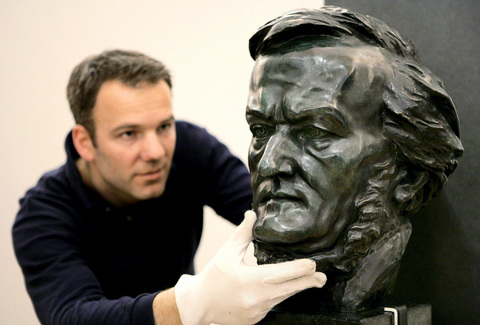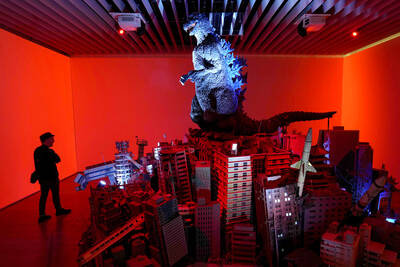Enormous statues that Adolf Hitler once adored are to be put on display in Germany for the first time since World War II in a move that has shocked many Germans.
The monolithic statues by sculptor Arno Breker are to form the focus of a retrospective of the artist's works at a museum in Schwerin in eastern Germany.
Critics say the venue and the timing could not be worse because Schwerin is the capital of Mecklenburg-Pomerania, which is in the midst of a hotly contested state legislature election campaign.

PHOTO: EPA
The far-right-wing National Party of Germany (NPD) has launched a well-financed campaign to win seats in the state legislature in the economically hard-hit state in eastern Germany. Polls show the NPD likely to win more than the minimum 5 per cent vote necessary to gain admittance to the state parliament house in Schwerin.
The Breker exhibit at Schwerin's Schleswig-Holstein Haus runs from July 22 through October 22 — coinciding with the state election in September. State officials have denied any deliberate connection between the two events.
“But one can't help thinking that Schwerin in actuality is attempting to rehabilitate Breker by mounting this unprecedented exhibit of his work,” said Klaus Staeck, president of the Berlin Academy of Arts.
Staeck, one of the nation's most influential artists, promptly announced he was withdrawing his own works from the Schwerin museum, which had planned to show Staeck's artwork next year.
“Breker is guilty of crimes against humanity and against art,” Staeck said in an interview. “And he never issued so much as an apology for his behavior.”
The Schwerin show, the first major exhibit of Breker's art in Germany since 1945, consists of 70 works spanning the range of his oeuvre from his early days as a German Expressionist, through the Nazi period and into the post-war era when he was still accepting lucrative commissions from public and private collectors, primarily from outside Germany.
Although he enjoyed considerable fame in France, where there is a museum devoted to his works, Breker died in comparative ignominy in Germany in 1991 at the age of 91.
Ironically, his artistic career in some ways mirrored the history of Germany in the 20th century. During the Weimar Republic he was a well-known adherent of the Expressionist school and his angular sculptures were admired by leftists. But the Nazis also liked his style. After the war, he was a successful commercial sculptor.
The monumental scale of his neo-Classical figures appealed to Hitler's dreams of over-sized grandeur. Saying that “unlike me, most other artists understand nothing of politics,” Hitler brushed aside Breker's leftist political leanings and gave him handsomely paid commissions for tremendously huge statuary.
Breker's gigantic figures of sinewy warriors and buxom nude maidens to this day adorn Berlin's Olympic Stadium and other public buildings erected in Germany during the 1930s.
The artist never denied that he was a frequent guest of Hitler, having later said, “Hitler liked to surround himself with artists since he fancied himself an artist as well.”
Thus after the fall of France in June 1940, Hitler asked Breker to give him a guided tour of the art and architecture of the French capital, where Breker had studied and lived for a time.
“Hitler took me aback during the tour by telling me straight out that he had come close to sending me to a concentration camp in 1934 because of anti-Nazi sentiments, but that he had decided to be magnanimous in the interests of Germanic art,” Breker said a few years before his death.
Breker always claimed he had used his influence to save the lives of Jews and anti-Nazi dissidents. They allegedly included fervent anti-Nazi agitator Jean Marais and Henry Matisse's wife and daughter.
After the war, US denazification authorities cleared Breker's name, saying they had no proof of complicity in Nazi crimes.
But Breker was never able to overcome the stigma of having been the sculptor whom an enthusiastic Hitler had once praised as “the Michelangelo of the Germanic race.”
His statues of brawny Aryan heroes have languished in storage rooms for decades. The Schwerin museum is the first to get permission from Breker's widow to put the statues on display.
Among the works is an enormous male nude charioteer which once stood in the Great Hall of Hitler's grandiose New Chancellory building in the heart of Berlin.
Museum director Rudolf Conrades defends the show by saying that it is time for Germans to take a long and hard look at Breker's entire career as an artist, if only as a demonstration of how a good artist with leftist ideals can be ensnared by a fascist totalitarian regime.
“At any rate, in a healthy democracy it is good to keep both eyes open and not to close an eye to what has gone disastrously wrong,” Conrades said.
“It is unhealthy to put taboos on a period of art that is an uncomfortable but yet undeniable part of our own history,” he added.
He said the show's accompanying catalogue would include essays highly critical of Breker.
These explanations leave Staeck unimpressed.
“Breker was nothing more than the decorator of barbarism,” he said flatly. “His work was Nazi propaganda in stone and has no intrinsic artistic value.”

Following the shock complete failure of all the recall votes against Chinese Nationalist Party (KMT) lawmakers on July 26, pan-blue supporters and the Chinese Communist Party (CCP) were giddy with victory. A notable exception was KMT Chairman Eric Chu (朱立倫), who knew better. At a press conference on July 29, he bowed deeply in gratitude to the voters and said the recalls were “not about which party won or lost, but were a great victory for the Taiwanese voters.” The entire recall process was a disaster for both the KMT and the Democratic Progressive Party (DPP). The only bright spot for

As last month dawned, the Democratic Progressive Party (DPP) was in a good position. The recall campaigns had strong momentum, polling showed many Chinese Nationalist Party (KMT) lawmakers at risk of recall and even the KMT was bracing for losing seats while facing a tsunami of voter fraud investigations. Polling pointed to some of the recalls being a lock for victory. Though in most districts the majority was against recalling their lawmaker, among voters “definitely” planning to vote, there were double-digit margins in favor of recall in at least five districts, with three districts near or above 20 percent in

From Godzilla’s fiery atomic breath to post-apocalyptic anime and harrowing depictions of radiation sickness, the influence of the nuclear bombings of Hiroshima and Nagasaki runs deep in Japanese popular culture. In the 80 years since the World War II attacks, stories of destruction and mutation have been fused with fears around natural disasters and, more recently, the Fukushima crisis. Classic manga and anime series Astro Boy is called “Mighty Atom” in Japanese, while city-leveling explosions loom large in other titles such as Akira, Neon Genesis Evangelion and Attack on Titan. “Living through tremendous pain” and overcoming trauma is a recurrent theme in Japan’s

The great number of islands that make up the Penghu archipelago make it a fascinating place to come back and explore again and again. On your next trip to Penghu, why not get off the beaten path and explore a lesser-traveled outlying island? Jibei Island (吉貝嶼) in Baisha Township (白沙鄉) is a popular destination for its long white sand beach and water activities. However, three other permanently inhabited islands in the township put a unique spin on the traditional Penghu charm, making them great destinations for the curious tourist: Yuanbeiyu (員貝嶼), Niaoyu (鳥嶼) and Dacangyu (大倉嶼). YUANBEIYU Citou Wharf (岐頭碼頭) connects the mainland